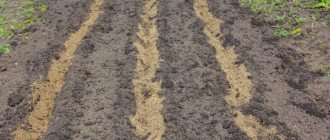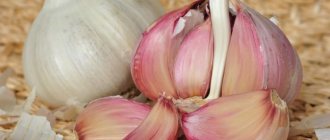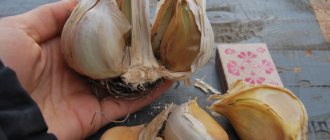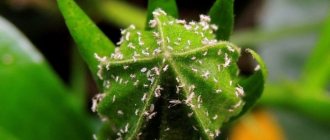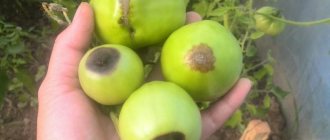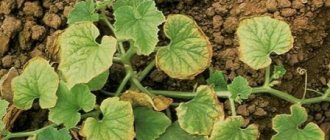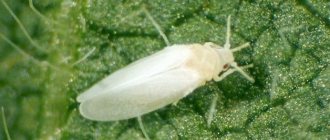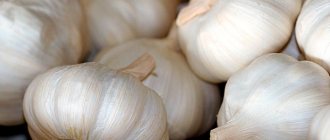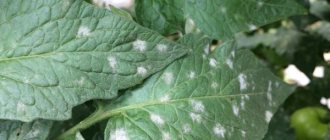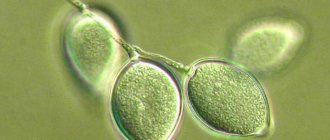What worms threaten onions
Damage to onions is caused by both adult insects and their larvae, which hatch from eggs laid in the soil or on its surface. Often a lesion is discovered when the root system is already damaged. Therefore, you need to know the signs of pests and their main external characteristics.
Root mite
This insect settles in the bulb, gradually eating it and causing it to rot. It affects both plantings and already harvested crops. A mature individual reaches 1.1 mm and is white to yellow in color.
The eggs are oval shaped and white. The female deposits them directly into the root system of the plant. After 2-3 weeks, larvae emerge from them. Both adults and young individuals feed on bulb tissues.
Important! Under unfavorable conditions, the root mite falls into a state of suspended animation, but as soon as a favorable environment appears, it becomes active again.
Signs of onion root mite damage include:
- mold and rot on the stem and root;
- head deformation;
- yellowing and drying of onion feathers;
- white coating on leaves;
- drying and gradual falling off of the roots from the bottom of the bulb.
Onion hoverfly
This insect attacks onions in the phase when the heads are already beginning to form. The size of a mature individual reaches 7 mm, and in appearance it is very similar to a fly. A distinctive feature is a bronze-greenish color and 2 gray stripes on the back.
In early May, the hoverfly lays eggs on the soil near the plantings, from which dirty-white worm-like larvae emerge after 5-10 days. It is they who feed on the pulp of the bulb.
Important! Onion hoverfly larvae overwinter in the ground and, with the onset of warmth, turn into pupae, from which adult insects emerge after 2-2.5 weeks.
The main signs of a plant being affected by the onion hoverfly include:
- wilting and yellowing of stems;
- growth arrest;
- softening of the head, blackening of the core;
- in case of massive damage to plantings, an unpleasant odor appears that accompanies rotting of the bulbs.
Onion fly
This pest settles in young seedlings and quickly affects all plantings, as it is able to move from a diseased plant to a healthy one. A mature individual of the onion fly reaches 8 mm, has an ash-gray body color and oblong-shaped yellow wings.
The fly lays white eggs on onion seedlings and in the soil around them. After 3-6 days, dirty-white larvae appear from them, which settle in the rhizome and feed on it.
Important! The danger of the onion fly lies in the development of several generations per season and its ability to remain in the soil for a long time without a nutrient medium.
Main signs of damage:
- mass wilting of plantings in the first leaf phase;
- the presence of larvae on the soil at the base of the plant;
- small holes in the bulb and feathers;
- rotting of the root system.
Stem nematode
This pest is capable of destroying the plant completely in 7-10 days, sucking the juice from the leaves and bulbs. In this case, the root system begins to rot, leading to the death of the seedling.
A mature individual has a thread-like body of white-yellow color and reaches a size of 1.5 mm. From very small eggs, invisible to the human eye, after 3-5 days larvae appear, outwardly similar to adults.
Symptoms of onion stem nematode damage include:
- yellowing and gradual drying of feathers;
- softening the bulbs;
- falling off of the husks and cracking of the surfaces of the heads;
- rotting of the rhizome;
- falling of roots located at the bottom;
- signs of rotting on the lower part of the stem.
The process of forming larvae into adults capable of reproduction takes 1.5 months.
Onion weevil
This pest destroys the stems of the plant, which negatively affects the development of the head.
A mature individual reaches a size of 3 mm and is black in color with a white longitudinal stripe on the back. In the first half of May, the insect lays small white eggs (0.5 mm) in the leaves of seedlings. Of these, oblong yellow larvae appear after 10-14 days.
Symptoms of onion weevil infestation:
- growth arrest;
- yellowing and fading of the arrows;
- irregularities along the edges of the leaves;
- whitish spots and arrows on the stems.
The pest overwinters in the upper layers of the soil and becomes active in mid-April.
Onion moth
The larvae of this insect infect the stems and roots of the plant, leading to its rotting and death.
A mature individual is a small brownish butterfly, reaching 1.5 mm. At the end of May, she lays oval yellow eggs in the onion stems, from which larvae emerge a week later. Their length is 1 cm, the color of the body is yellow-green. A distinctive feature is brown warts that completely cover the body of the larva.
Signs of onion moth damage include:
- growth arrest;
- wilting of leaves;
- the appearance of long longitudinal stripes on the stems;
- yellowing and fading of the arrows;
- bulb rotting.
The second generation of plants appears after 3 weeks, so treatment with drugs must be carried out several times per season.
Thrips
This pest can damage not only plantings, but also crops in storage.
A mature individual reaches 1.3 mm and has a brown or dirty yellow color, yellow antennae and red eyes. The insect lays white, barrel-shaped eggs in onion stems. After 4-5 days, white or light yellow larvae emerge from them.
Symptoms of thrips damage to onions include:
- growth arrest;
- change in shape and yellowing of stems;
- signs of rotting in the entire seedling;
- silvery or white stripes on the leaves;
- small onions.
The second generation of insects develops in about 20 days, so pesticide treatment is carried out several times per season.
Wireworm
This is the larva of a click beetle that infects the root part of the plant. The wireworm develops over several years, all this time being in the soil and constantly infecting plantings.
Signs of wireworm damage to onions include:
- drying of plant stems;
- holes in the bulbs.
The click beetle is capable of laying larvae on a large number of plantings. Timely treatment with special preparations stops its reproduction and destroys all generations of the insect.
Onion fly
Symptoms
If you suddenly notice yellowed tips of feathers, drooping arrows or curling of onions while planting onions, it means that the onion fly, the most common pest, has settled in the beds.
The onion fly is similar to a regular fly, only it is gray in color and 1 cm long. When the lilac blooms, the fly begins to actively fly and look for a place to lay eggs. The best place for this is dry onion scales at the very base. The larvae bite into the bulbs and “gobble up” the juicy pulp for three weeks, eating through extensive passages.
The leaves of the plant wither, turn yellow and then dry out completely, and the bulb emits an unpleasant odor. The larvae go into the ground, where by July they turn into flies, fly out and damage all crops with renewed vigor. In the southern regions, where onions are grown in large quantities, three generations of flies grow per season.
Treatment and prevention
If you have already observed onion infestation with a fly, then most likely the soil is already contaminated with pupae of this pest. Therefore, digging up the soil in early spring will give a good result: the pupae will be exposed to cold air and most of them will disappear.
What other means are there?
A good proven drug “Zemlin”, which fights many soil-dwelling pests. It is simply scattered on the surface of the soil. It has long been known that the onion fly avoids laying eggs in carrot plantings, so this fact must be used.
Advice! Plant two crops close to each other, at the optimal distance, not forgetting that as they grow, carrots become spreading. Good experience: line method, alternating onions and carrots.
When planting, you can reduce the likelihood of a fly laying eggs in onion scales by deepening the set by 3 cm during planting, hiding the neck in the ground.
Traditional methods of struggle:
- From the moment the feather grows 3–5 cm, watering with a saline solution is used: 200 g of salt per 10 liters of water, watering once every 10 days.
- Ammonia solution: 3 tablespoons per 10 liters of water.
Water so that the solutions do not get on the leaves! If you find damaged bulbs, remove them mercilessly!
What to do if onions are eaten by white worms
If damage to the onion by harmful insects is detected, the diseased plant is immediately removed along with a lump of earth. Then the soil and plantings are treated with chemical or biological preparations and folk remedies.
The following agricultural methods are also used:
- Mustard, marigolds, mint, calendula and carrots, which contain substances that repel pests, are planted next to the onions;
- regularly weed the plantings;
- loosen the soil;
- thin out;
- mulch;
- constantly inspect seedlings;
- observe the watering regime.
All these actions will help prevent insect damage to the onion and will significantly reduce the spread of pests if they appear.
Features of choosing a method of dealing with a worm
When choosing a means to combat onion worms, you need to consider:
- the degree of negative impact on culture,
- level of safety for the environment;
- availability;
- having a detrimental effect on human health;
- affected area.
For small areas it is more advisable to use folk remedies; for treating large areas it is better to use chemical solutions.
To minimize the harm caused to plants, it is recommended to use organic substances and preparations. They enrich the soil with additional nutrition and improve the soil structure.
How to water onions for worms
Ready-made commercial preparations and folk remedies are equally effective against all pests that attack onions. The latter are most often used when there are less than 2 weeks left before harvest, since chemicals tend to accumulate in plant tissues.
Chemicals
Chemicals are used to kill pests on young onion seedlings. When growing plants for feathers, they are not used.
Preparations applied to the soil:
- "Fly-eater";
- "Zemlin";
- "Medvetox".
These products are evenly distributed on the surface of the soil, which is then thoroughly loosened.
The following preparations are used to spray leaves:
- "Fitoverm";
- "Iskra DE";
- "Soil."
A prerequisite for the use of chemicals is strict adherence to the instructions indicated on the packaging.
Biological drugs
This type of product is as effective as chemicals, but practically does not accumulate in plant tissues. Therefore, they can be used at any growing season.
How to treat onions for worms:
- "Trichodermin." To prepare the product, 30 g of the drug is diluted in 30 liters of water.
- "Metronidazole". 4 tablets are diluted in 10 liters of water and sprayed on the plantings.
Folk remedies
Folk remedies for onion pests will not only destroy all generations of insects, but also saturate the plants with nutrients.
Important! Treatment of plantings with folk remedies is carried out 3 times per season, taking breaks between them of at least 2 weeks.
The most effective include:
- Ash. 100 g of the product are diluted in 10 liters of water and sprayed on the plants.
- Dandelion decoction. Brew 200 g of flowers in 1 liter of water and leave for 2-3 days. The concentrate is diluted in 10 liters of water and sprayed onto the plantings.
- Soap. Dissolve 200 g of laundry soap shavings in 10 liters of warm water. Add the solution to the soil and spray the seedlings.
- Salt. Dissolve 300 g of table salt in 10 liters of water and water the onion beds with the product.
Helpful Tips for Protecting Onions
By following some tips, you can prevent onions from becoming infested with pests.
- Compliance with crop rotation (plant onions in their original place no earlier than after 5 years).
- Carrying out sowing on time with zoned varieties.
- Autumn and spring digging of the landing site.
- Disinfection with a solution of copper sulfate before planting.
- Maintain distance between crops during planting for good ventilation.
- Timely removal of weeds.
- Treatment with biological products during the germination and feather ejection phases.
- Checking and processing planting material before planting.
- Identification and destruction of infected plants.
How to treat onions to prevent the appearance of worms
To prevent insects from infesting onion plantings, the seed is soaked in a weak solution of potassium permanganate. Then the seeds are thoroughly dried and planted in previously prepared soil.
Tilling the land before planting onions
Proper soil treatment will help prevent onion plantings from being damaged by pests. To do this, perform a number of actions:
- in the fall they dig up the beds, plunging the shovel into the ground at full bayonet level;
- in spring, 2 weeks before planting, add 300 g of lime per 1 m² and 20 g of ammonium nitrate per 1 m² to the soil;
- After planting the seedlings, sprinkle the soil with 1 tbsp. l. wood ash per 1 m².
After watering, be sure to loosen the soil, since in conditions of high humidity the larvae spread faster.
Wood ash
For opponents of the use of chemicals in the garden, wood ash is a godsend in the fight against pests and diseases of onions. The microelements contained in it will also improve the composition of the soil. Ash mixed in equal quantities with tobacco dust can pollinate vegetable beds. After this, the soil is shed.
It is better to pour onion roots with infusions of ash, which will lead to healthier plants. And the worms will quickly leave the plant bed. It is enough to dilute 2 kilograms of wood ash in a bucket of water and carry out the treatment.
Potassium permanganate
Of the disinfectants, potassium permanganate is most suitable for destroying fly larvae and disinfecting soil. But you need to make a weak solution if the onion is young, so as not to damage the delicate tissues of the vegetable.
Vegetables grown on bulbs are watered twice with an interval of 2 weeks. Before planting, it is necessary to disinfect the soil with a solution of potassium permanganate.
Seed material must be immersed in a pinkish solution for 20-30 minutes to protect it from disease and damage by larvae.
Biological drugs
Using chemicals to kill onion fly larvae is not always useful. If a vegetable is grown for feathers, what should you do, because it will not be possible to eat it. Therefore, it is necessary to turn to effective and safe drugs.
"Trichodermin"
One of the best drugs, Trichodermin, has a wide spectrum of action. It contains biologically active substances that can protect vegetable crops. The effectiveness of the drug lies in its active components, which produce enzymes similar to antibiotics.
The introduction of spore material into the soil can improve the quality characteristics of the soil and suppress the development of pathogenic microorganisms. As soon as the onion fly larvae appear, the beds begin to be treated. The solution is prepared at the rate of 3 grams of powder per 3 liters of water.
Plantings are treated in the morning or evening in calm weather. After spraying, do not water the onions. With abundant watering, active trichodermins can be washed away. To consolidate the result, carry out the procedure again after 10 days, since it is not always possible to get rid of the pest the first time.
"Metronidazole"
Methods to combat worms on onions include the use of the well-known antibacterial agent Metronidazole. The tablets are used against many pests: nematodes, onion flies. A tablet dissolved in water is capable of normalizing a vegetable plant and restoring tissue damaged by pests in just a few treatments. For a garden bed, you need to dissolve 4 tablets of the product in a bucket of water, mix thoroughly and spray. Spraying must be carried out more than once to consolidate the result of the procedure.
You can simply water the plants at the root with a biological solution. Such methods are effective against both pests and fungal infections.
